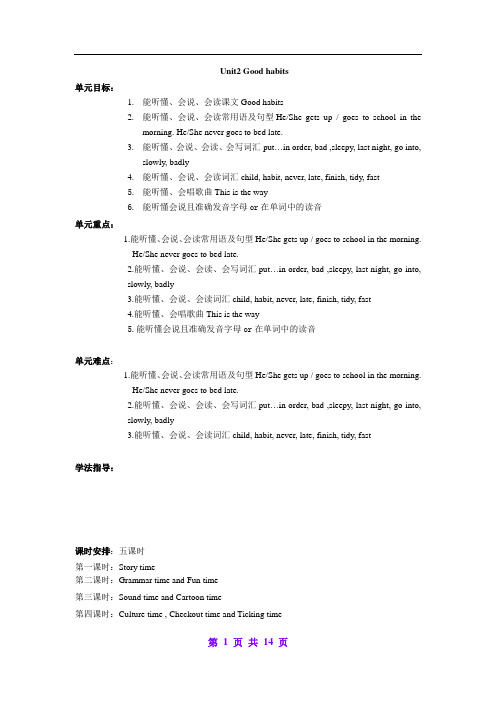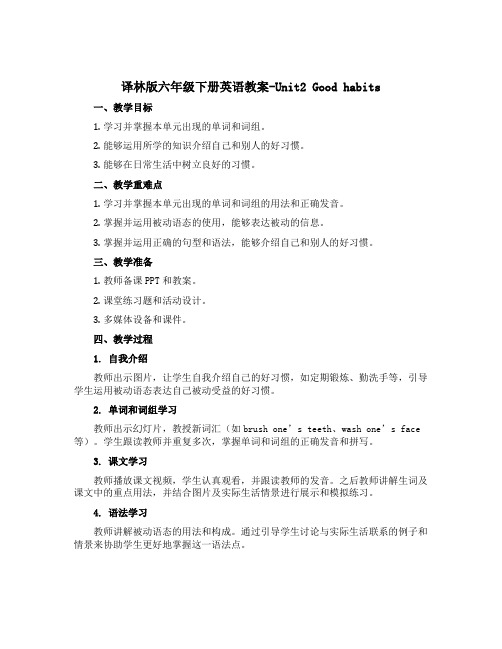译林版小学六年级英语下册教案Unit 2 Good habits_教案3
- 格式:doc
- 大小:2.05 MB
- 文档页数:4

Unit2 Good habits单元目标:1.能听懂、会说、会读课文Good habits2.能听懂、会说、会读常用语及句型He/She gets up / goes to school in themorning. He/She never goes to bed late.3.能听懂、会说、会读、会写词汇put…in order, bad ,sleepy, last night, go into,slowly, badly4.能听懂、会说、会读词汇child, habit, never, late, finish, tidy, fast5.能听懂、会唱歌曲This is the way6.能听懂会说且准确发音字母or在单词中的读音单元重点:1.能听懂、会说、会读常用语及句型He/She gets up / goes to school in the morning.He/She never goes to bed late.2.能听懂、会说、会读、会写词汇put…in order, bad ,sleepy, last night, go into,slowly, badly3.能听懂、会说、会读词汇child, habit, never, late, finish, tidy, fast4.能听懂、会唱歌曲This is the way5.能听懂会说且准确发音字母or在单词中的读音单元难点:1.能听懂、会说、会读常用语及句型He/She gets up / goes to school in the morning.He/She never goes to bed late.2.能听懂、会说、会读、会写词汇put…in order, bad ,sleepy, last night, go into,slowly, badly3.能听懂、会说、会读词汇child, habit, never, late, finish, tidy, fast学法指导:课时安排:五课时第一课时:Story time第二课时:Grammar time and Fun time第三课时:Sound time and Cartoon time第四课时:Culture time , Checkout time and Ticking time第五课时:Review and do some exercisesThe first period Date:教学内容:Story time教学目标:1. 能正确理解、朗读课文并可以根据提示复述课文内容。

教案:六年级下册英语教案 Unit 2 Good habits 第四课时译林版三起一、教学目标1. 知识目标:(1)能够听懂、会说、会读本课时的核心单词:cartoon, movie, story, song, radio, TV, morning, afternoon, evening, brush, clean, exercise, read, sleep。
(2)能够听懂、会说、会读本课时的核心句型:What time do you ? I at2. 能力目标:能够用英语描述自己的日常习惯,并能够询问他人的习惯。
3. 情感目标:培养学生养成良好习惯的意识,激发学生对英语学习的兴趣。
二、教学内容本课时主要讲述日常生活中的好习惯,通过学习本课时,学生能够描述自己的日常习惯,并能够询问他人的习惯。
三、教学重点与难点1. 教学重点:(1)掌握本课时的核心单词。
(2)能够运用核心句型描述自己的日常习惯,并能够询问他人的习惯。
3. 教学难点:如何引导学生运用英语描述自己的日常习惯,并能够询问他人的习惯。
四、教具与学具准备1. 教具:PPT、单词卡片、录音机、磁带。
2. 学具:课本、练习本、文具。
五、教学过程1. 热身(5分钟)(1)教师与学生进行简单的英语对话,检查学生对之前所学知识的掌握情况。
(2)学生进行简单的英语口语练习,如:自我介绍、问候他人等。
2. 导入(10分钟)(1)教师播放本课时的录音,让学生听录音并跟读。
(2)教师通过PPT展示本课时的核心单词,引导学生学习并掌握单词。
3. 新课教学(20分钟)(1)教师通过PPT展示本课时的核心句型,引导学生学习并掌握句型。
(2)教师结合核心句型,让学生进行角色扮演,模拟实际场景,运用英语描述自己的日常习惯,并能够询问他人的习惯。
4. 练习与巩固(15分钟)(1)教师出示一些日常习惯的图片,让学生用英语描述图片中的习惯。
(2)学生进行小组活动,用英语互相描述自己的日常习惯,并能够询问他人的习惯。

教案:六年级下册英语教案 Unit 2 Good Habits 第3课时译林版三起教学目标:1. 能听懂、会说、会读本节课的生词和重点句子。
2. 能够运用所学知识进行简单的日常交流,谈论好习惯和坏习惯。
3. 培养学生的语言表达能力,提高他们的听说读写技能。
教学内容:1. 单词:habit, brush, teeth, morning, afternoon, evening, bath, healthy, watch, TV, exercise, read, book, before, after, too much, spend, time2. 重点句子:I have a good habit.I don't have a good habit.Do you have a good habit?Yes, I do. / No, I don't.教学重点与难点:1. 重点:单词的正确发音和拼写,句子的运用。
2. 难点:单词“too much”和“spend time”的用法,以及句子“Do you have a good habit?”的提问和回答。
教具与学具准备:1. 教具:PPT,图片,单词卡片,录音机,磁带。
2. 学具:课本,练习本,铅笔,橡皮。
教学过程:1. 热身(5分钟)老师与学生进行简单的英语对话,活跃课堂气氛。
学生自由发言,分享自己的一天作息时间。
2. 引入(10分钟)老师通过PPT展示一些图片,引导学生说出图片中的好习惯和坏习惯。
学生听录音,跟读生词和句子。
3. 新课内容(15分钟)老师通过PPT讲解新课内容,引导学生学习新单词和句子。
学生跟读,模仿老师的发音和语调。
4. 课堂活动(10分钟)学生分成小组,进行角色扮演,用所学单词和句子进行交流。
老师巡回指导,纠正学生的发音和语法错误。
5. 巩固练习(10分钟)老师给出一些情景,让学生用所学知识进行回答。
学生独立完成练习题,老师批改并给予反馈。

六年级下册英语教案-Unit 2 Good habits 第三课时-译林版三起教学内容•Unit 2 Good habits第三课时的学习,包括新单词、句型和语法知识的学习和训练,以及听、说、读、写等综合应用能力的训练。
教学目标•掌握并运用新词汇的基本含义和用法;•通过训练,掌握和运用新的句型和语法知识,能够进行简单的沟通和表达;•通过课堂练习和参与,提高听、说、读、写能力,培养综合应用能力。
教学重点•新单词的掌握和运用;•新句型和语法知识的掌握和运用;•听、说、读、写综合应用能力的提高。
教学难点•语音和语调;•新句型和语法知识的掌握和运用。
教学过程1. Class opening•Greetings: Good morning, students!2. Review(1) Review the vocabularies.•Teacher: Who can tell me what the words “wash”, “brush”, and “exercise” mean?•Students: (Answer)(2) Review the sentences.•T: Please complete the sentences with the words in the box.。
•S: (Answer)3. Presentation(1) Present the new vocabularies.•T: Today, we are going to learn three new words: “sleep”, “clean”, and “walk”. Can you guess what they mean?•S: (Answer)•T: Yes, you are right! “Sleep” means to rest your body and mind, “clean” means to make something free from dirt and dust, and “walk” means to move on your feet.(2) Present the new grammar.•T: Look at these sentences. (Show two sentences: I sleep ___ hours every night. She walks ___ kilometers to school.)•T: Can you tell me what’s missing in these two sentences?•S: (Answer)•T: Yes, you are right. We need to fill in the blank with a number. This is how we express the amount of something. Do you understand?•S: (Answer)4. Practice(1) Practice the new vocabularies.•T: Please match the phrase with correct word.•S: (Answer)(2) Practice the new grammar.•T: Please fill in the blanks with a number according to the context.•S: (Answer)5. Production(1) Individual work•T: Can you describe your daily routine using the words we learned today?•S: (Answer)(2) Group work•T: Please work in groups and make a dialogue using the new grammar and vocabularies.•S: (Answer)6. Summary•T: Today we learned three new words and how to use numbers to express the amount of something. Can you tell me what they are?•S: (Answer)7. Homework•T: Please write a short paragraph about your daily routine using the new grammar and vocabularies we learned today.•S: (Answer)Conclusion通过本节课的学习与练习,学生们掌握了三个新词汇的基本含义和用法,并掌握了如何用数字表达某一事物的数量。


译林版六年级下册英语教案-Unit2 Good habits一、教学目标1.学习并掌握本单元出现的单词和词组。
2.能够运用所学的知识介绍自己和别人的好习惯。
3.能够在日常生活中树立良好的习惯。
二、教学重难点1.学习并掌握本单元出现的单词和词组的用法和正确发音。
2.掌握并运用被动语态的使用,能够表达被动的信息。
3.掌握并运用正确的句型和语法,能够介绍自己和别人的好习惯。
三、教学准备1.教师备课PPT和教案。
2.课堂练习题和活动设计。
3.多媒体设备和课件。
四、教学过程1. 自我介绍教师出示图片,让学生自我介绍自己的好习惯,如定期锻炼、勤洗手等,引导学生运用被动语态表达自己被动受益的好习惯。
2. 单词和词组学习教师出示幻灯片,教授新词汇(如brush one’s teeth、wash one’s face 等)。
学生跟读教师并重复多次,掌握单词和词组的正确发音和拼写。
3. 课文学习教师播放课文视频,学生认真观看,并跟读教师的发音。
之后教师讲解生词及课文中的重点用法,并结合图片及实际生活情景进行展示和模拟练习。
4. 语法学习教师讲解被动语态的用法和构成。
通过引导学生讨论与实际生活联系的例子和情景来协助学生更好地掌握这一语法点。
5. 句型学习教师讲解如何介绍别人的好习惯,如运用“What about…”这一句型,引导学生模拟对话进行练习。
6. 课堂练习学生在课堂上完成教师出的练习题,包括单选题、填空题和阅读理解题等,巩固和提高所学知识点的应用能力和学习效果。
7. 活动设计分组活动:教师将学生分成若干组,让每组学生讲述一个好习惯,其他同学则进行点评和改进建议,从而提高语言表达和交流能力。
8. 作业布置教师布置课后练习和阅读任务,督促学生复习所学知识点和掌握单词和词组的使用和发音。
五、教学总结本节课主要以自我介绍、单词和词组学习、课文学习、语法学习和句型学习为主要教学内容,通过课堂练习和活动设计,帮助学生掌握课文知识点,加强课堂互动交流和口语表达能力,切实提高英语学习的效果和质量。
Unit 2 Good habits.教案设计Contents of this class教学内容:Cartoon time & Sound timeTeaching aims and learning objectives教学目标:1. 能掌握字母组合or在单词中的发音,并适当扩展运用。
2. 能理解Cartoon time的内容并动手实践。
3. 能意识到good habits的重要性并能在学习生活中自觉养成。
Teaching emphasis and difficulties教学重难点:1 会字母组合or在单词中不同的发音在单词中的辨别。
2. 能意识到good habits的重要性并能在学习生活中自觉养成。
3. 能锻炼运用英语及与他人合作的能力设计意图:1好的习惯能让学生受益终生,并能让学习事半功倍,因此,在学习Good habits的同时要让学生养成良好习惯。
2使用“读单词―教对话―做练习―找问题―强化训练”这样的教学模式。
英语学习正变得越来越机械、枯燥,越来越多的学生正在对英语失去兴趣,以此,在课堂上要多还原英语作为言语的本色,多让学生用英语交流。
Preparation教学准备:,练习纸、课件、简笔画(苹果、花等,其中苹果上写上单词,标上序号)Teaching procedures教学过程:Step 1 Warming up1 Greeting and make a self-introductionShow a picture of me and try to ask me questions about my English name, hobby, best friend, and favorite color. I will ask the Ss the same questions,the Ss try to make a self-introduction.2 Tina’s e-mailMy best friend Tina invited me and other friends to her house.We should bring some presents. Encourage the Ss to get my flowers for Tina.设计意图:1通过师生问答,模拟真实情景运用英语,提高对英语的兴趣。
六年级下册英语教案Unit2 Good habits 译林版(三起)3一、教学目标1. 知识与技能:(1)学生能够理解并运用本单元的重点单词和短语,如:habit, make, keep, healthy, etc.(2)学生能够理解并运用本单元的重点句型,如:“I have a habit of ”, “It helps me ”, etc.(3)学生能够听懂、会说、会读本单元的对话和故事。
2. 过程与方法:(1)通过图片、实物、情景创设等方式,引导学生理解单词和句型的含义。
(2)通过角色扮演、小组讨论等形式,提高学生的英语口语表达能力。
(3)通过课后练习,巩固所学知识,提高学生的英语综合运用能力。
3. 情感态度与价值观:(2)培养学生关爱他人,乐于助人的品质。
二、教学内容1. 单词:habit, make, keep, healthy, etc.2. 句型:“I have a habit of ”, “It helps me ”, etc.3. 对话:关于生活习惯的对话。
4. 故事:关于生活习惯的故事。
三、教学重点与难点1. 重点:单词和短语的理解和运用,句型的理解和运用,对话和故事的理解和表达。
2. 难点:句型的正确运用,对话和故事的理解和表达。
四、教具与学具准备1. 教具:图片、实物、PPT、录音机等。
2. 学具:课本、练习册、笔等。
五、教学过程1. 导入:通过图片、实物等引导学生复习已学过的单词和句型,为新课的学习做好铺垫。
2. 新课呈现:通过情景创设、讲解、示范等方式,教授新课的内容。
3. 操练:通过角色扮演、小组讨论等形式,让学生在实际语境中运用所学知识。
4. 巩固:通过课后练习、小测验等方式,巩固所学知识。
5. 作业布置:布置与新课相关的作业,让学生课后进行复习和巩固。
六、板书设计1. 单词和短语:habit, make, keep, healthy, etc.2. 句型:“I have a habit of ”, “It helps me ”, etc.3. 对话和故事的主要内容和表达方式。
Unit 2Good habits【教学目标】1. 能正确理解、朗读课文并可以根据提示复述课文内容。
2. 能听懂、会读、会说单词: tidy, messy, habits, in order, finish, sleepy, bedtime。
3. 能尝试根据所学短语和句型来描述自己的习惯。
4. 能初步根据提示写出好的习惯。
5. 能分清好坏习惯,并知道以好的习惯来要求自己,让自己拥有更多好的习惯。
【课前准备】1. 单词卡片/时间展示图;2. 教学光盘或其他录音机设备;3. 教学课件。
【教学过程】Step 1:Warm up and lead inBoys and girls, let’s play a game first. If you think it is right, you read the sentence. If you think it is wrong, you say bomb, ok? (通过游戏,引出主题,调动学生的学习兴趣。
)Step 2:Presentation1. What is the game about? They are about habits. And you read those good habits just now. So today, we are going to learn U2 Good habits. Follow.2. Boys and girls, we need good habits, so do our good friends: Wang Bing and Liu Tao. They also have good habits in their daily lives. First , let’s take a look at Liu Tao’s habits. Please listen and tick. (先解决刘涛的习惯,唤醒学生对于习惯的好坏的评判意识,为将其与学生自身行为习惯结合做铺垫。
六年级下册英语教案-Unit 2 Good habits-译林版一、教学目标1.知识目标:•掌握并能正确使用以下单词:chore, shake, wipe, peel, fold, put away.•熟练掌握以下句型:“I usually…” 和“I never…”。
•能够明白并能介绍好的生活习惯。
•能够听懂关于好的生活习惯的对话,并进行模仿。
2.能力目标:•让学生能够发散思维,激发他们好的生活习惯的意识。
•让学生练习表达自己的想法并尝试合作完成活动。
•让学生学会进行听和说的交流以及在大班环境中表达自己的观点。
3.情感目标:•培养学生良好的生活习惯,让他们懂得如何自我管理,增强他们的自信心和自尊心。
•培养学生共同合作的意识,让他们相互协作,分工合作,共同建设美好的学习环境。
二、教学重点•熟练掌握以下单词:chore, shake, wipe, peel, fold, put away.•能够明白并能介绍好的生活习惯。
•能够听懂关于好的生活习惯的对话,并进行模仿。
三、教学难点•让学生练习表达自己的想法并尝试合作完成活动。
•让学生学会进行听和说的交流以及在大班环境中表达自己的观点。
四、教学过程1. 导入让学生可以认识好的生活习惯。
2. 展开•引导全班一起找出生活中的好习惯,比如说:勤洗手、依时睡觉等。
•要求每位学生列出个人生活中的三个好习惯。
•从其中选几个例子,让学生进行分组,然后互相讨论他们的习惯并搜集大家的想法,然后一位同学进行领读。
3. 讲学•老师介绍“Good habits”这个话题,重点介绍以下单词:chore, shake, wipe, peel, fold, put away。
•通过PPT给学生展示每个单词的图片以及对应的发音。
•教授这些单词的意义和用法,引导学生进行基础的复述演练。
4. 作业让学生回家写下他们今天所进行的生活习惯,并且判断自己的习惯是好还是坏的。
五、总结通过课堂教学,让学生树立和培养良好的生活习惯,使他们能够认知到自己的习惯的好与坏,提高自我管理和协助能力,提高大家的社会发展素质等。
Unit 2 Good habits
Period 3
【教学目标】
1.能理解并体会字母组合or在单词中的发音,并适当扩展不同的发音。
2.能理解Cartoon time的内容并动手实践。
3.能意识到good habits的重要性并付诸于实际生活
【教学重点】
1.能理解并体会字母组合or在单词中的发音,并适当扩展不同的发音。
2.能意识到good habits的重要性并付诸于实际生活。
3.能锻炼运用英语及与他人合作的能力。
【教学难点】
1.能理解并体会字母组合or在单词中的发音,并适当扩展不同的发音。
2.能意识到good habits的重要性并付诸于实际生活。
【教学准备】
PPT 练习纸
【教学过程】
Step 1 Preparation
1.Greeting and make a self-introduction
Show a picture of me and let Ss ask me questions about my English name, hobby, best friend, and favorite color.
2.Tina’s e-mail
My best friend Tina invited me and other friends to her house.
We should bring some presents. Encourage the Ss to get my apples and flowers for Tina.
Step 2 Presentation
1.Sound time
Challenge1: Reading.
Rule: You can get my flowers by reading the words correctly and well.
Let ’s enjoy a rhyme about my favorite animal —horses.
Four sh or t h or ses,
Running through the grass.
Four sh or t h or ses,
Running very fast!
Let ’s read some words in the rhyme and think the pronunciation of “or”.
f or h or se sh or t sp or t
Make a conclusion: or /ɔ: /
Let ’s read the rhyme and words in four. (Flowers)
Challenge2: Picking apples.
Rule: You can get my apples by knowing the different pronunciations of “or”.
Find and discuss in 4. 摘下or 字母组合发/ɔ:/的苹果。
Apples: forty, morning, or, corn, pork, north, work, world, actor, doctor.
Make a conclusion: “or” can not only be pronounced /ɔ: /, it can also be pronounced /ə/ and /ə: /.
2.Cartoon time
We got some apples and flowers for Tina, so let ’s go into Tina ’s house.
Miss Rabbit and Mr. Duck come to Tina ’s house, too. They are talking. Let ’s listen.
Q: How many rooms do they talk about? What are they?
S1: Three. They are a living room, Tina ’s bedroom and Bobby ’s bedroom.
Let ’s go into Tina ’s house and look at the rooms.
f
m o c
do w
a w o n
Listen and repeat.
Tip: Try to imitate the pronunciation and intonation.
choice1: Read it together.
choice2: Each student reads a sentence.
choice3: Read in roles.自己分配角色。
Step 3 Consolidation
1.Look and talk
Bobby’s bedroom is messy and dirty. (出示图片) Let’s help him and give him some suggestions.
We can say: We should…
Make a conclusion: We should put our things in order and keep good habits.
2.Write a diary.
Tip: Write down three suggestions.
Thursday, Dec. 11th
Today we took some _____ and ______to Tina’s _____. Firstly, we ____ ____ the living room. It’s ____and _____. Then we went into____ bedroom. It’s _____ but ____. At last we went into _______ _______. It’s _____ and ____. There were a lot of _____ and ____ on the floor. Tina was very _____ because Bobby had ____ habits. She told Bobby that he should ____ everything ___ ____. I thought he should ____________, _____________, and _______________.
Step 4 Homework
1.Read sound time and the story three times.
2.Tell the story to your parents.
【板书设计】
Unit 2 Good habits
sport horse
for short or /ɔ:/。